

-who was she?
the man stares back at him silently
for a moment, then with resignation in his
face, speaks.
-i thought you'd like to meet your
enemy before you fought her.
-what? why didn't you just have me
kill her right there? while she was
helpless?
-that's none of your concern. let's
just say it's important that you fight on
even ground.
-so the next assignment then...
the man nods.
-she's a weapon. a deadly one. but she
is more than that. she lures her targets
to isolated areas with the promise of sex.
they never get a second date.
-her method?
-a sword. despite her youthful
appearance, she's extremely well trained.
he looks at the man gravely. a sword?
of all the things for him to come up
against it had to be some teenaged samurai
succubus.
-so how do i find her in action?
-the information you gathered at the
bunker, it details her usual "places of
business". there are designated areas she
kills at, where later the thaylor
coporation goons come to clean up the
evidence. it depends on where in the city
she's used, but it seems the most often
utilised location is a theatre. it's all
detailed here. you're to find and kill her
at all costs.
the man drops a envelope and a
bottle.
-i'll see that it gets done.
-i know you will.
• • • • • • • • •
"It had to be some teenage samurai succubus..." is excellent. The thread of blackmail for murder is gone entirely. This mystererious operative has the complete loyalty of the protagonist, despite our protagonist having no real idea who he's working for or what their purpose is. He'll question them, but not pry. He's enjoying the violence too much to try and rationlize anything.
The game's final mission is to track down this woman to a theatre and defeat her.

After the bulk of the game being abstract locations built around gameplay rather than creating a realistic setting, we get to see Commodore try his hand at depicting a run down part of town. The game's location is never stated within the ZZT world, but Commodore has stated in the game's z2 thread for the project that it takes place in Hong Kong.

As with the previous mission, the player's health is set back to 100, and his ammo reclaculated.
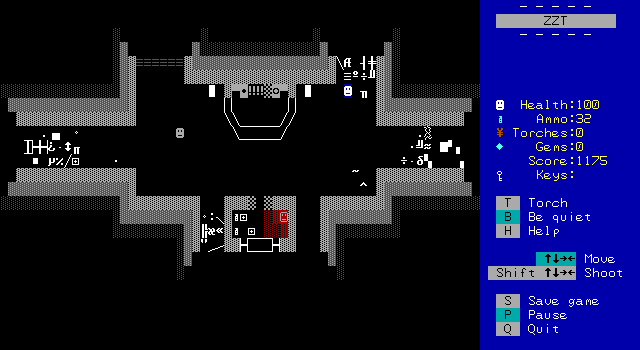
She's killed already, with the messy and run down theatre's employee being found dead in a nearby room. She's also still here, and immediately runs into the auditorium for her and the player to stage their battle in.
We get some final little details with Commodore taking the time to make sure the lobby has a concession counter. It uses almost exclusively non-modified graphics, but does an excellent job conveying what it's supposed to be.

This part of town is definitely not a safe one. The player can pick up some more health and ammo before the last confrontation.
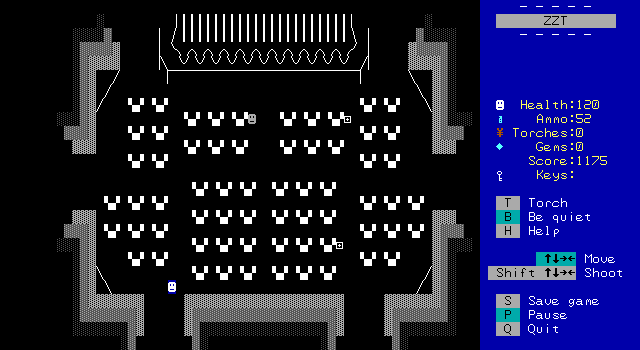
The room is empty except for these two. This final boss fight plays out very differently than the corridor shooting from before. She fights the player with a sword, no gun, and she is very deadly with it. Getting struck by her takes off 40 health, leaving very little room for error. She's the fastest thing in the game by a considerable margin and runs down the aisle or between the seats rapidly and unpredictably enough that it's tough to get a bead on her to shoot.
She's also quite stealthy! Whether the implication is some form of technology letting her cloak, or just plain hiding behind seating, she can frequently turn completely invisible and reposition herself. You'll never be sure of where she'll strike from in this fight, and it works quite well.

Her movement speed combined with stealth went so far as to make me suspect there were actually multiple objects for her, and one would turn invisible and move to a set location, then send a different one elsewhere out, but she is just that fast.
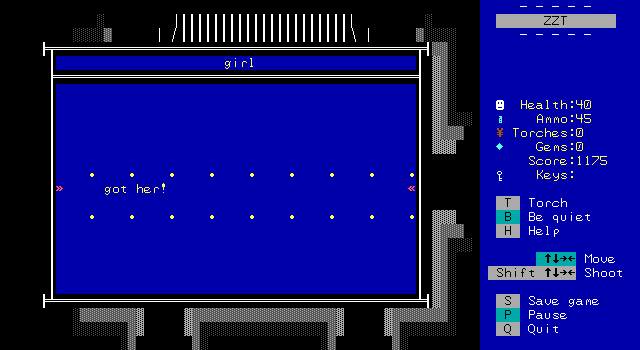
She is strong as well, but the challenge is more being able to hit her at all rather than worrying about how much damage needs to be dealt. She only needs to be shot twice before she retreats, and the player gives chase.


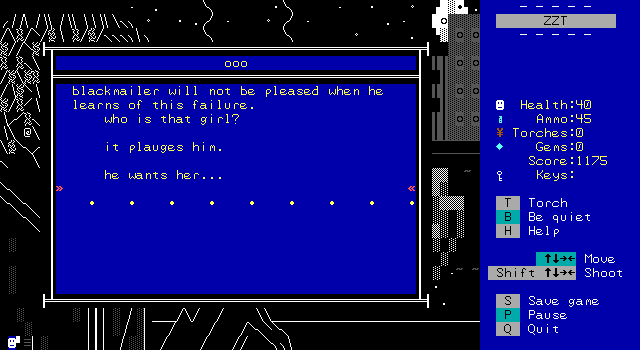

The game ends, not surprinsingly with a cliffhanger. She got away and of course our protagonist is falling for this mysterious woman with a sword. We get one last excellent art board with a depiction of our protagonist against a nighttime skyline of Hong Kong. Commodore again does a fantastic job of the limited character modifications he made to make a nice profile view and a very well drawn gun. Keep in mind he's fighting with tiles that are 8x14, making even simple angles difficult to create. I also love how much mileage he gets out of his modifications. That hair is just as much of the forcefield from the factory or shattering glass of his apartment window. And at the same time, it's all still ZZT with its jagged full moon in the background./p>
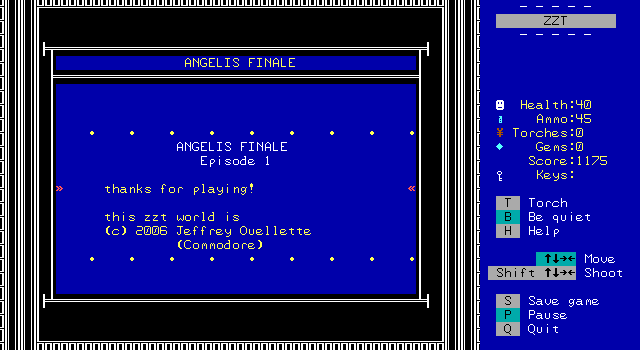
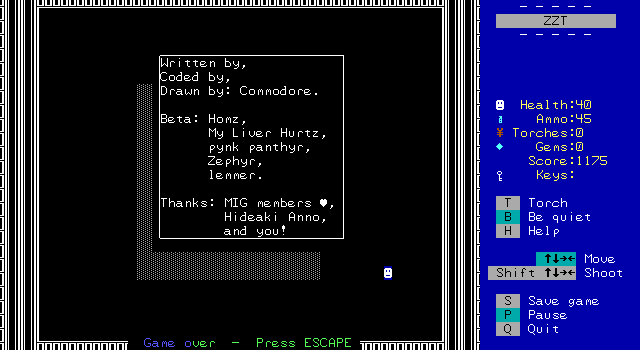
The game ends with some straightforward credits: Commodore and the beta testers. Hideaki Anno, the creator of Neon Genesis Evangelion is thanked.
Final Thoughts
Commodore's Angelis Finale is easily ZZT's most well crafted action game. It can't be overstated just how handily it beats the competition in one of ZZT's most prolific genres. Action games are one of the easiest things to make in ZZT. All you need to do is press F2 and start placing some lions. Commodore however, manages to build levels with thought put into the design, how the player will navigate those spaces, and how to best position his enemies so that they'll actually be effective at attacking the player.
Angelis Finale isn't afraid to break tradition, requiring the player to adjust the speed the game is played at, and mandating the use of a custom font. The former is critical to the game working. Transforming slow moving bullets into blazing fast attacks that feel nearly instant. Had the game been designed around the standard speed, it would have been a well made ZZT world, that would stand out due to its other aspects, but I don't think the gameplay would have been noteworthy compared to any other action game out there. (Playing the game as is on default speed is a miserable experience as everything moves excruciatingly slowly.)
The custom font is something underutilized in ZZT as well. When working with them, it's pretty easy to discover why. A lot of what makes ZZT's graphical style work is its abstractness. Adjusting passages to look like doors or stairs means as soon as the player needs to enter a cave, the graphical change becomes a hindrance. The font changes Commodore made really work to enhance the game not so much in the individual tiles, but in the large scaled artwork. You'll still some of ZZT's standard graphical tropes in place like the yen symbols for plants rather than a new graphic. The font focuses mainly on adding more styles and angles of lines and uses them effectively to create visuals that provide more opportunities for drawing while keeping things abstract.
Without its font, Angelis Finale would lose a lot of what makes it so distinct. I've seen a lot of explosions in code page 437. I've seen shattered glass, and I've seen plenty of mysterious individuals whose motives are unclear. Commodore is able to render these things in a way that feels fresh visually.
And it's the game's striking visuals combined with its story that really make it feel special. There's little actually explained, and you can simply go in and shoot the "bad guys" without any thought, but then that's exactly how the protagonist is experiencing things. All the aspects of the game, graphics, level design, and story combine to create something truly memorable. I can't recommend Angelis Finale enough, and only wish it had been released earlier in ZZT's history to have given us a game that would have inspired others to follow in its footsteps. Don't miss out on playing this one for yourself.


